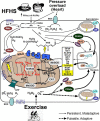The "Goldilocks Zone" from a redox perspective-Adaptive vs. deleterious responses to oxidative stress in striated muscle
- PMID: 25278906
- PMCID: PMC4166897
- DOI: 10.3389/fphys.2014.00358
The "Goldilocks Zone" from a redox perspective-Adaptive vs. deleterious responses to oxidative stress in striated muscle
Abstract
Consequences of oxidative stress may be beneficial or detrimental in physiological systems. An organ system's position on the "hormetic curve" is governed by the source and temporality of reactive oxygen species (ROS) production, proximity of ROS to moieties most susceptible to damage, and the capacity of the endogenous cellular ROS scavenging mechanisms. Most importantly, the resilience of the tissue (the capacity to recover from damage) is a decisive factor, and this is reflected in the disparate response to ROS in cardiac and skeletal muscle. In myocytes, a high oxidative capacity invariably results in a significant ROS burden which in homeostasis, is rapidly neutralized by the robust antioxidant network. The up-regulation of key pathways in the antioxidant network is a central component of the hormetic response to ROS. Despite such adaptations, persistent oxidative stress over an extended time-frame (e.g., months to years) inevitably leads to cumulative damages, maladaptation and ultimately the pathogenesis of chronic diseases. Indeed, persistent oxidative stress in heart and skeletal muscle has been repeatedly demonstrated to have causal roles in the etiology of heart disease and insulin resistance, respectively. Deciphering the mechanisms that underlie the divergence between adaptive and maladaptive responses to oxidative stress remains an active area of research for basic scientists and clinicians alike, as this would undoubtedly lead to novel therapeutic approaches. Here, we provide an overview of major types of ROS in striated muscle and the divergent adaptations that occur in response to them. Emphasis is placed on highlighting newly uncovered areas of research on this topic, with particular focus on the mitochondria, and the diverging roles that ROS play in muscle health (e.g., exercise or preconditioning) and disease (e.g., cardiomyopathy, ischemia, metabolic syndrome).
Keywords: adaptation; carbonyl stress; heart; hormesis; lipid peroxidation; mitochondria; redox environment; skeletal muscle.
Figures



References
-
- Akita Y., Otani H., Matsuhisa S., Kyoi S., Enoki C., Hattori R., et al. (2007). Exercise-induced activation of cardiac sympathetic nerve triggers cardioprotection via redox-sensitive activation of eNOS and upregulation of iNOS. Am. J. Physiol. Heart Circ. Physiol. 292, H2051–H2059 10.1152/ajpheart.01102.2006 - DOI - PubMed
-
- Ambroziak W., Pietruszko R. (1991). Human aldehyde dehydrogenase. activity with aldehyde metabolites of monoamines, diamines, and polyamines. Biol. Chem. 266, 13011–13018 - PubMed
-
- Anderson E. J., Efird J. T., Davies S. W., O'Neal W. T., Darden T. M., Thayne K. A., et al. (2014a). Monoamine oxidase is a major determinant of redox balance in human atrial myocardium and is associated with postoperative atrial fibrillation. J. Am. Heart Assoc. 3:e000713 10.1161/JAHA.113.000713 - DOI - PMC - PubMed
-
- Anderson E. J., Kypson A. P., Rodriguez E., Anderson C. A., Lehr E. J., Neufer P. D. (2009). Substrate-specific derangements in mitochondrial metabolism and redox balance in the atrium of the type 2 diabetic human heart. J. Am. Coll. Cardiol. 54, 1891–1898 10.1016/j.jacc.2009.07.031 - DOI - PMC - PubMed
Publication types
Grants and funding
LinkOut - more resources
Full Text Sources
Other Literature Sources

